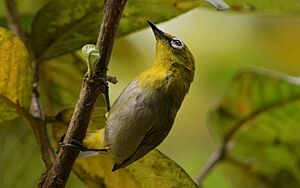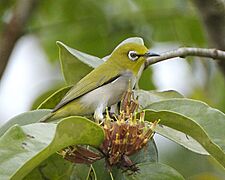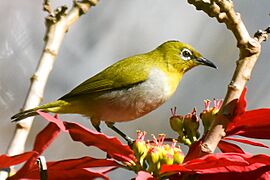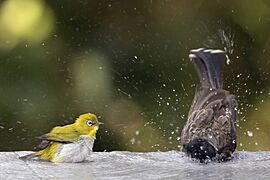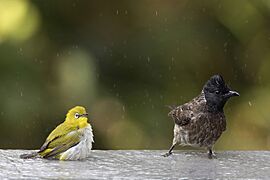Indian white-eye facts for kids
Quick facts for kids Indian white-eye |
|
|---|---|
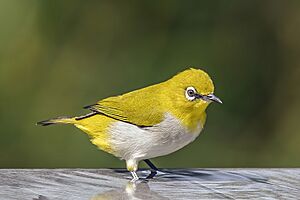 |
|
| Z. p. egregius, Sri Lanka | |
| Conservation status | |
| Scientific classification | |
| Genus: |
Zosterops
|
| Species: |
palpebrosus
|
| Synonyms | |
|
Sylvia palpebrosa |
|
The Indian white-eye (Zosterops palpebrosus) is a small bird from the white-eye family. It used to be called the Oriental white-eye. These birds live in open woodlands across the Indian subcontinent. They often look for food in small groups. They eat nectar from flowers and tiny insects. You can easily spot them by the clear white ring around their eyes and their yellowish feathers. Their name changed recently to Indian white-eye because some birds that used to be part of this group in Southeast Asia are now considered different species. This new name better shows where these birds live.
Contents
About the Indian White-Eye
How the Indian White-Eye Got Its Name
The Indian white-eye was first described by a Dutch zoologist named Coenraad Jacob Temminck in 1824. He studied a bird from Bengal, India. He gave it the scientific name Sylvia palpebrosa.
Both the English name and the scientific name come from the bright white ring of feathers around the bird's eyes. The word palpebrosus means "having prominent eyelids" in Neo-Latin. It comes from the Latin word palpebrae, which means "eyelids."
The bird's English name was changed from "Oriental white-eye" to "Indian white-eye." This change happened to better show where the bird lives. Other similar birds, like Hume's white-eye and the warbling white-eye, are now seen as separate species.
What the Indian White-Eye Looks Like
This bird is quite small, usually about 8 to 9 centimeters (about 3 to 3.5 inches) long. Its upper body is yellowish-olive, and it has a clear white ring around its eyes. Its throat is yellow, and its belly is usually whitish-grey. Some birds might have a bit of yellow on their belly. Both male and female Indian white-eyes look very similar.
There are different types of Indian white-eyes, called subspecies, that live in various places. For example, the birds in the Western Ghats of India are a bit different from those in Sri Lanka.
Where the Indian White-Eye Lives
You can find the Indian white-eye in many different places, from bushy areas to damp forests. They sometimes live in mangrove forests, like those near Karachi, Pakistan. On islands, they might eat more insects. They are less common in the very dry desert parts of western India.
In the 1980s, some Indian white-eyes were found living in the wild in San Diego, California. However, these birds were later removed from the area.
Life and Habits of the Indian White-Eye
Social Life and Nesting
Indian white-eyes are very social birds. They usually live in flocks, which are groups of birds. These flocks only break up when it's time for them to breed. They spend most of their time in trees and rarely come down to the ground.
The breeding season for these birds is from February to September, with April being the busiest time. They build a neat, cup-shaped nest that looks like a small hammock. They place it in the fork of a tree branch. The nest is made from spiderwebs, small pieces of lichen, and plant fibers. It takes them about four days to build a nest.
Female white-eyes usually lay two pale blue eggs within a few days of each other. The eggs hatch in about 10 days. Both the male and female birds help to take care of the young chicks. The chicks are ready to leave the nest after about 10 days.
What They Eat
Indian white-eyes mainly eat insects. However, they also enjoy eating nectar from flowers and different kinds of fruits.
Calls and Other Behaviors
These birds often make soft, nasal "cheer" calls while they are looking for food. When they visit flowers, they help to pollinate them. They might be looking for tiny insects like thrips on the flowers, or perhaps even nectar. Sometimes, pollen can stick to their foreheads, which can make them look a bit different. They have also been seen bathing in dew that collects on leaves.
When they have a nest, Indian white-eyes might try to chase away palm squirrels. Since they are small birds, they often have to defend themselves from predators. Their predators include bats, especially the greater false vampire bat, and other birds like the white-throated kingfisher.
Sometimes, white-eyes will take nesting materials from other birds' nests. There have even been cases where white-eyes were seen feeding the chicks of other bird species, like a paradise flycatcher.
Even though they are not very strong fliers, Indian white-eyes can travel long distances. Strong winds and storms can carry them to new areas, including islands far from the mainland.
Images for kids
-
This bird in Maharashtra has an orange forehead due to pollen staining
-
Bathing alongside red-vented bulbul in Sri Lanka



